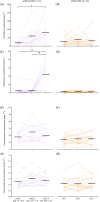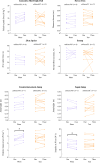Minimal influence of the menstrual cycle or hormonal contraceptives on performance in female rugby league athletes
- PMID: 38877892
- PMCID: PMC11295101
- DOI: 10.1002/ejsc.12151
Minimal influence of the menstrual cycle or hormonal contraceptives on performance in female rugby league athletes
Abstract
We examined performance across one menstrual cycle (MC) and 3 weeks of hormonal contraceptives (HC) use to identify whether known fluctuations in estrogen and progesterone/progestin are associated with functional performance changes. National Rugby League Indigenous Women's Academy athletes [n = 11 naturally menstruating (NM), n = 13 using HC] completed performance tests [countermovement jump (CMJ), squat jump (SJ), isometric mid-thigh pull, 20 m sprint, power pass and Stroop test] during three phases of a MC or three weeks of HC usage, confirmed through ovulation tests alongside serum estrogen and progesterone concentrations. MC phase or HC use did not influence jump height, peak force, sprint time, distance thrown or Stroop effect. However, there were small variations in kinetic and kinematic CMJ/SJ outputs. NM athletes produced greater mean concentric power in MC phase four than one [+0.41 W·kg-1 (+16.8%), p = 0.021] during the CMJ, alongside greater impulse at 50 ms at phase one than four [+1.7 N·s (+4.7%), p = 0.031] during the SJ, without differences between tests for HC users. Among NM athletes, estradiol negatively correlated with mean velocity and power (r = -0.44 to -0.50, p < 0.047), progesterone positively correlated with contraction time (r = 0.45, p = 0.045), and both negatively correlated with the rate of force development and impulse (r = -0.45 to -0.64, p < 0.043) during the SJ. During the CMJ, estradiol positively correlated to 200 ms impulse (r = 0.45, p = 0.049) and progesterone to mean power (r = 0.51, p = 0.021). Evidence of changes in testing performance across a MC, or during active HC use, is insufficient to justify "phase-based testing"; however, kinetic or kinematic outputs may be altered in NM athletes.
Keywords: estrogen; female; progesterone; sex hormones; strength; women.
© 2024 The Author(s). European Journal of Sport Science published by Wiley‐VCH GmbH on behalf of European College of Sport Science.
Conflict of interest statement
Authors declare no conflict of interest.
Figures



Similar articles
-
Effect of Menstrual Cycle Phase and Hormonal Contraceptives on Resting Metabolic Rate and Body Composition.Int J Sport Nutr Exerc Metab. 2024 Apr 23;34(4):207-217. doi: 10.1123/ijsnem.2023-0193. Print 2024 Jul 1. Int J Sport Nutr Exerc Metab. 2024. PMID: 38653456
-
Skating sprint performance and the influence of lower-body strength and power in professional and junior elite ice hockey athletes.Sports Biomech. 2024 Dec;23(12):3382-3393. doi: 10.1080/14763141.2023.2218326. Epub 2023 Jun 5. Sports Biomech. 2024. PMID: 37272123
-
Relationship between countermovement jump performance and multijoint isometric and dynamic tests of strength.J Strength Cond Res. 2008 May;22(3):699-707. doi: 10.1519/JSC.0b013e31816d5eda. J Strength Cond Res. 2008. PMID: 18438251
-
The effect of the phase of the menstrual cycle and the birth control pill on athletic performance.Clin Sports Med. 1994 Apr;13(2):419-41. Clin Sports Med. 1994. PMID: 8013042 Review.
-
Athletic performance and the oral contraceptive.Int J Sports Physiol Perform. 2009 Jun;4(2):151-62. doi: 10.1123/ijspp.4.2.151. Int J Sports Physiol Perform. 2009. PMID: 19567919 Review.
Cited by
-
The menstrual cycle minimally affects cardiorespiratory function and body balance control in trained women during acute hypobaric hypoxia exposure (4000 m).Eur J Appl Physiol. 2025 Apr 30. doi: 10.1007/s00421-025-05770-w. Online ahead of print. Eur J Appl Physiol. 2025. PMID: 40304768
-
The effect of time of day and menstrual cycle on physical performance and psychological responses in elite female Tunisian volleyball players.BMC Sports Sci Med Rehabil. 2025 Apr 2;17(1):67. doi: 10.1186/s13102-025-01117-2. BMC Sports Sci Med Rehabil. 2025. PMID: 40176188 Free PMC article.
References
-
- Ansdell, P. , Brownstein C. G., Skarabot J., Hicks Kirsty M., Simoes Davina C. M., Thomas Kevin, Howatson Glyn, Hunter Sandra K., and Goodall Stuart. 2019. “Menstrual Cycle‐Associated Modulations in Neuromuscular Function and Fatigability of the Knee Extensors in Eumenorrheic Women.” Journal of Applied Physiology 126(6): 1701–1712. 10.1152/japplphysiol.01041.2018. - DOI - PubMed
-
- Barel, E. , Krispil M., and Yaari I.. 2019. “Cognitive Performance across the Menstrual Cycle.” Journal of Cognitive Psychology 4(47): 41–47.
MeSH terms
Substances
Grants and funding
LinkOut - more resources
Full Text Sources
Miscellaneous

